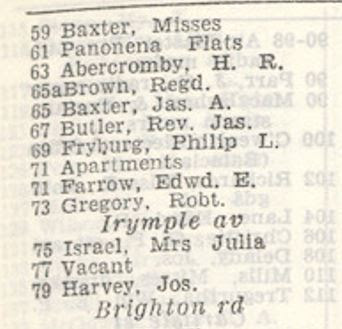Florence Cottage, 4 Mahoney Street, Fitzroy
Carlo and Catherine married on May 18, 1886 and their address on the marriage certificate was Marney Street, Fitzroy. This is a phonetic rendering of Mahoney Street. Whilst they were living in Fitzroy their first child Edward or Edoardo was born on June 2, 1886 and as noted on his birth certificate his place of birth was Florence Cottage, Mahoney Street, Fitzroy. Little Edward died on June 14, 1887 and the address on his death certificate was 4 Mahoney Street.
Carlo is in the City of Fitzroy Rate books dated November 1886 and December 1887. He is listed as the owner and the building is described as being of four rooms and constructed of brick.
116 Malvern Road, Prahran
Sometime between May 1888 - the birth of Elvira - and before November 1888 - the date of the City of Prahran Rate book - Carlo and Catherine moved to a five room brick house at 116 Malvern Road, Prahran (later numbered as 468) owned by Reuben Jackson. Carlo is also listed at Malvern Road in the November 1889 Prahran Rate books.
54 Murray Street, Prahran
The City of Prahran Rate books show that in November 1890 the Catani family were at 54 Murray Street, Prahran (originally numbered as 16) renting a 6 roomed weatherboard house from William Davies. The Catani's third child, Enrico Ferdinando was born while they were living at 54 Murray Street on January 19, 1891.
By December 1892, the Catanis had moved from Murray Street to Oak Avenue in Elsternwick. In February 1893, the Shire of Caulfield Rate books list Carlo in a nine-room brick house in Oak Avenue, Carlo owned the house with the mortagee, the Royal Insurance Company. On March 15, 1893, their third son and fourth child, Ettore Luigi was born there.
Dandenong Road, East Malvern
At some time they moved from Oak Avenue to a property on Dandenong Road, East Malvern and this is where their second daughter and fifth child, Eugenia Anastasia was born on August 13, 1895.
As we can see from the entry in the 1895 Sands McDougall Directory, below, the house was two doors up from the Turf Club Hotel, between Clarence Street and Tooronga Road.
Glenluce, 4 Elm Grove, Armadale
In 1897, the family made the move to Glenuce, 4 Elm Grove in Armadale. This was a newly constructed weatherboard house of ten rooms. The last child of Carlo and Catherine, a daughter named Enid Marguerite, was born at Glenluce on November 3, 1899. They lived there until around May 1912, when the house was removed for railway duplication works - I have written about this here.





.jpg)










.JPG)











